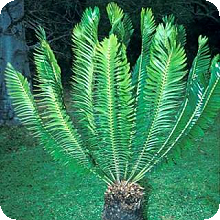| |||
| Division: Cycadophyta |
| Class: Cycadopsida |
| Order: Cycadales |
| Family: Zamiaceae |
| Genus: Encephalartos |
| Species: E. heenanii |
Conservation Status: |

E. heenanii
Woolly CycadEncephalartos heenanii, also known as Heenan's Cycad or Woolly Cycad, is widespread on the border between Swaziland and South Africa. Its specific epithet is in honor of Denis Heenan, a cycad collector who recognised this plant as a new species, and was indicated to the botanist Robert Allen Dyer (1900-1987) who described it formally.
The stems of E. heenanii are well-developed and suckering or branching from the base. Mature trunks are erect or become procumbent with age. They are up to 3m long and 400mm in diameter. The cataphylls are linear-lanceolate, often persisting in a dry brittle form on the upper half of the trunk and are very densely woolly with long golden brown hairs in the crown.
Leaves are 1m to 2m long, the rachis is incurved and often slightly twisted at the apex, giving a cup-like appearance to the plant’s crown. The petiole can be up to 200mm long and is round in cross section.
Median pinnae are succubously orientated, ascending in the plane of the rachis and markedly reflexed from the rachis. Leaflets are oblong-lanceolate in outline, 100mm to 150mm long and up to 20mm broad. The margins are entire or have 1 to 2 teeth. The lower leaflet surface has prominently raised veins and while the upper surface often has small wart-like protuberances. Lower leaflets are reduced but not to a series of prickles.
Male cones are usually single or in groups of 2 to 4. They are sub-cylindrical in shape and pedunculate. They are 270mm to 300mm in length, 120mm to 180mm in diameter and covered with dense brown wool. Cones are seldom glabrous. The male cone is similar in appearance to the female cone. A single female cone is usually produced and rarely 3. It is pedunculate, broadly ovate and 200mm to 350mm long, 170mm to 200mm in diameter and covered with dense shaggy golden hair but is often a glabrous yellow.
Cultivation:
This species has little horticultural potential and is notoriously difficult to cultivate. Mature plants seldom survive transplanting and desiccate easily after removal. Plants are also prone to fungal attack after transplanting. Seedlings are rare in trade, due to the fact that plants seldom cone in cultivation. Plants are rarely seen in cultivation and will probably always be a sought after collectors item.
| semi-shade | dark green | low watering | slow growth | frost-resistant | rare |
This species has little horticultural potential and is notoriously difficult to cultivate. Mature plants seldom survive transplanting and desiccate easily after removal. Plants are also prone to fungal attack after transplanting. Seedlings are rare in trade, due to the fact that plants seldom cone in cultivation. Plants are rarely seen in cultivation and will probably always be a sought after collectors item.
Available E. heenanii at Africa Cycads:
